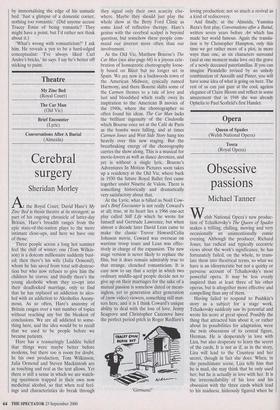Theatre
Brief Encounter (Lyric) Conversations After A Burial (Almeida) My Zinc Bed (Royal Court) The Car Man (Old Vic)
Cerebral surgery
Sheridan Morley
At the Royal Court, David Hare's My Zinc Bed is thesis theatre at its strongest; as part of his ongoing chronicle of latter-day Britain, Hare's breadth ranges from the epic state-of-the-nation plays to the more intimate close-ups, and here we have one of those.
Three people across a long hot summer feel the chill of winter; one (Tom Wilkin- son) is a dotcom millionaire suddenly bust- ed; then there's his wife (Julia Ormond), whom he has saved from total self-destruc- tion but who now refuses to give him the children he craves; and thirdly there's the young alcoholic whom they co-opt into their deadlocked marriage, only to find that he has replaced an addiction to alco- hol with an addiction to Alcoholics Anony- mous. As so often, Hare's anatomy of Britain ranges over a vast number of topics without reaching any but the bleakest of conclusions. We are all addicted to some- thing here, and the idea would be to recall that we used to be people before we became patients.
Hare has a reassuringly Luddite belief that things were maybe better before modems, but there too is room for doubt. In his own production, Tom Wilkinson, Julia Ormond and Steven Mackintosh are as touching and real as the text allows. Yet there is still a sense in which we are watch- ing specimens trapped in their own now medicinal alcohol, so that when real feel- ings and characteristics do break through they signal only their own scarcity else- where. Maybe they should just play the whole show at the Betty Ford Clinic as some kind of reflective therapy. Hare's genius with the cerebral scalpel is beyond question, but somehow these people com- mand our interest more often than our involvement.
At the Old Vic, Matthew Bourne's The Car Man (see also page 68) is a joyous cele- bration of homoerotic choreography loose- ly based on Bizet but no longer set in Spain. We are now in a backwoods town of the American Midwest, cynically named Harmony, and there Bourne shifts some of the Carmen themes to a tale of love and lust and bloodshed which really owes its inspiration to the American B movies of the 1940s, where the choreographer so often found his ideas. The Car Man lacks the brilliant ingenuity of the Cinderella which Bourne once set at the Café de Paris as the bombs were falling, and at times Carmen Jones and West Side Story hang too heavily over this new staging. But the breathtaking energy of the choreography carries the show along. This is a musical for movie-lovers as well as dance devotees, and yet is without a single lyric. Bourne's Adventures In Motion Pictures soon takes up a residency at the Old Vic, where back in 1930 the future Royal Ballet first came together under Ninette de Valois. There is something historically and dramatically very satisfactory about that.
At the Lyric, what is billed as Noel Cow- ard's Brief Encounter is not really Coward's at all; true, at its heart lies a 1966 one-act play called Still Life which he wrote for himself and Gertrude Lawrence, but when almost a decade later David Lean came to make the classic • Trevor Howard/Celia Johnson movie, Coward was overseas on wartime troop tours and Lean was effec- tively in charge of the expansion. The new stage version is never likely to replace the film, but it does remain admirably true to that strange, clenched romanticism. It is easy now to say that a script in which two ordinary middle-aged people decide not to give up on their marriages for the sake of a mutual passion is somehow dated or mean- ingless, yet to generation after generation of (now video) viewers, something still mat- ters here, and it is I think Coward's unique ability to deal with the loss of love. Jenny Seagrove and Christopher Cazenove have the perfect period pitch in Roger Redfarn's `Germans! ' loving production; not so much a revival as a kind of rediscovery.
And finally, at the Ahneida, Yasmina Reza's first play, Conversations after a Burial, written seven years before Art which has made her world famous. Again the transla- tion is by Christopher Hampton, only this time we get rather more of a plot, in more ways than one, as six characters surround (and at one moment make love on) the grave of a newly deceased paterfamilias. If you can imagine Pirandello revised by an unholy combination of Anouilh and Pinter, you will have some idea of what is going on here. The rest of us can just gaze at the cool, ageless elegance of Claire Bloom and reflect in some amazement that in 1948 she was already Ophelia to Paul Scofield's first Hamlet.






















































































 Previous page
Previous page